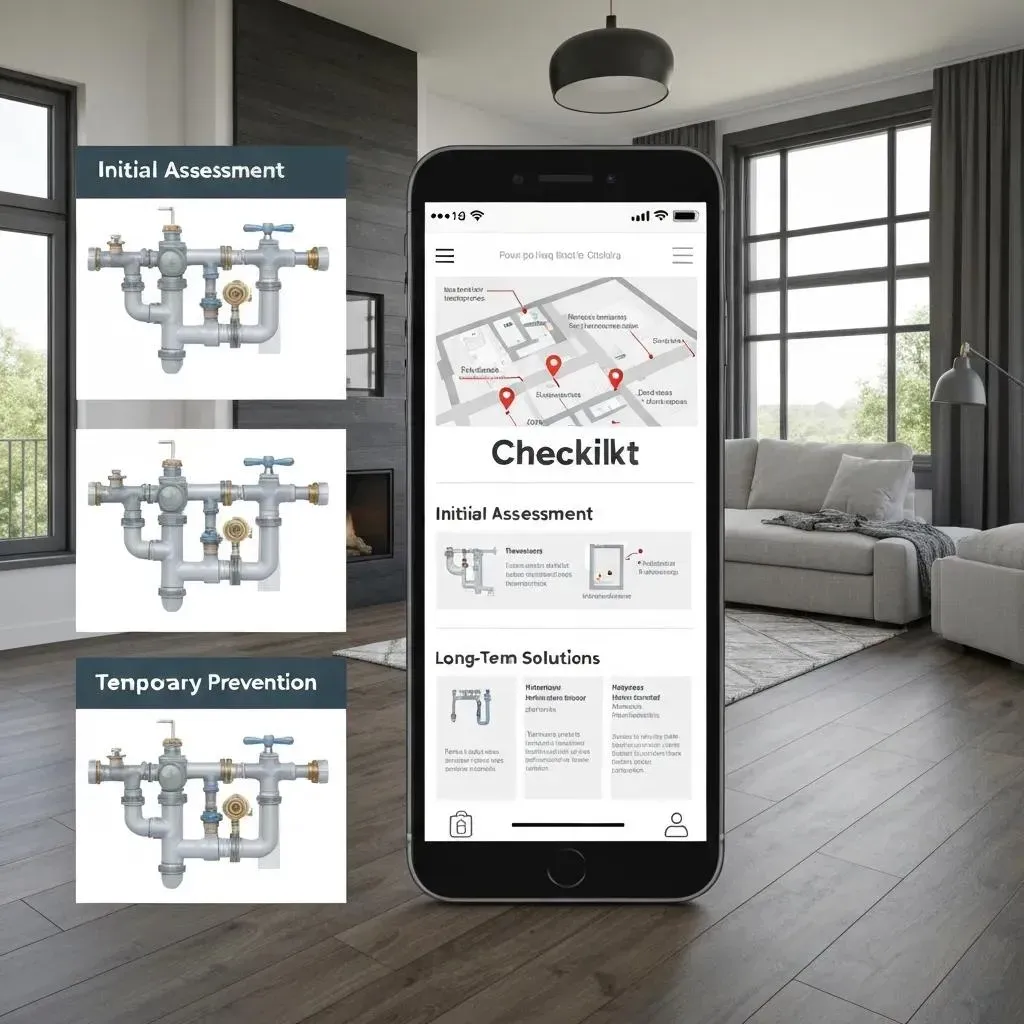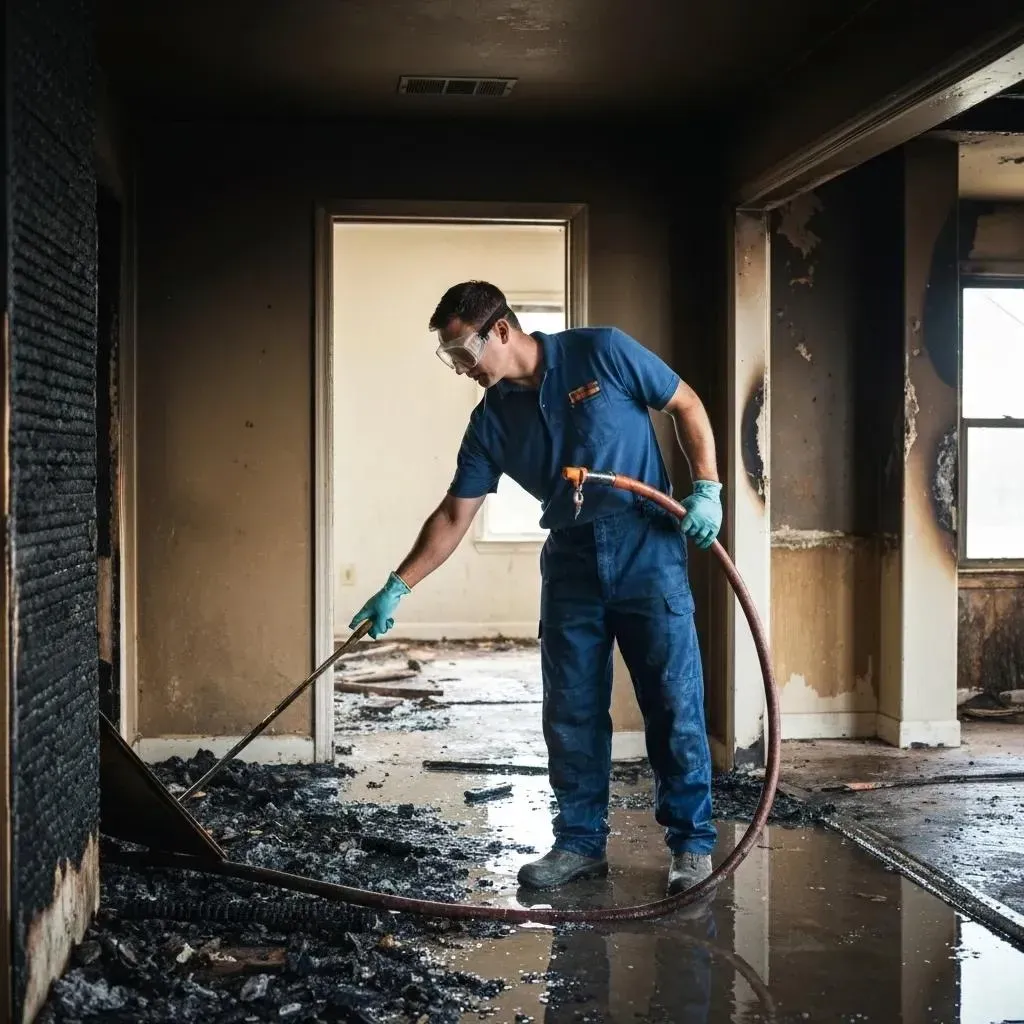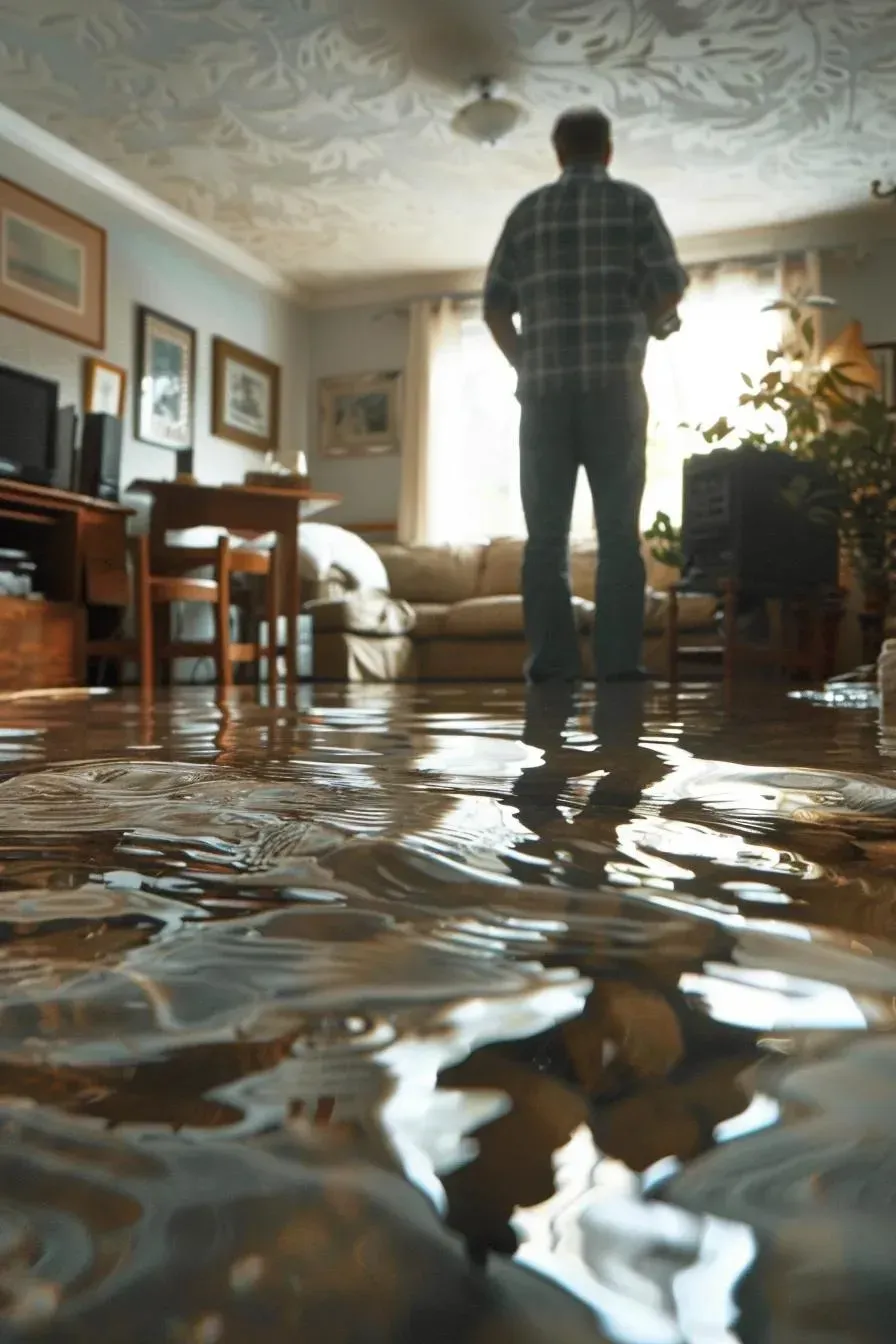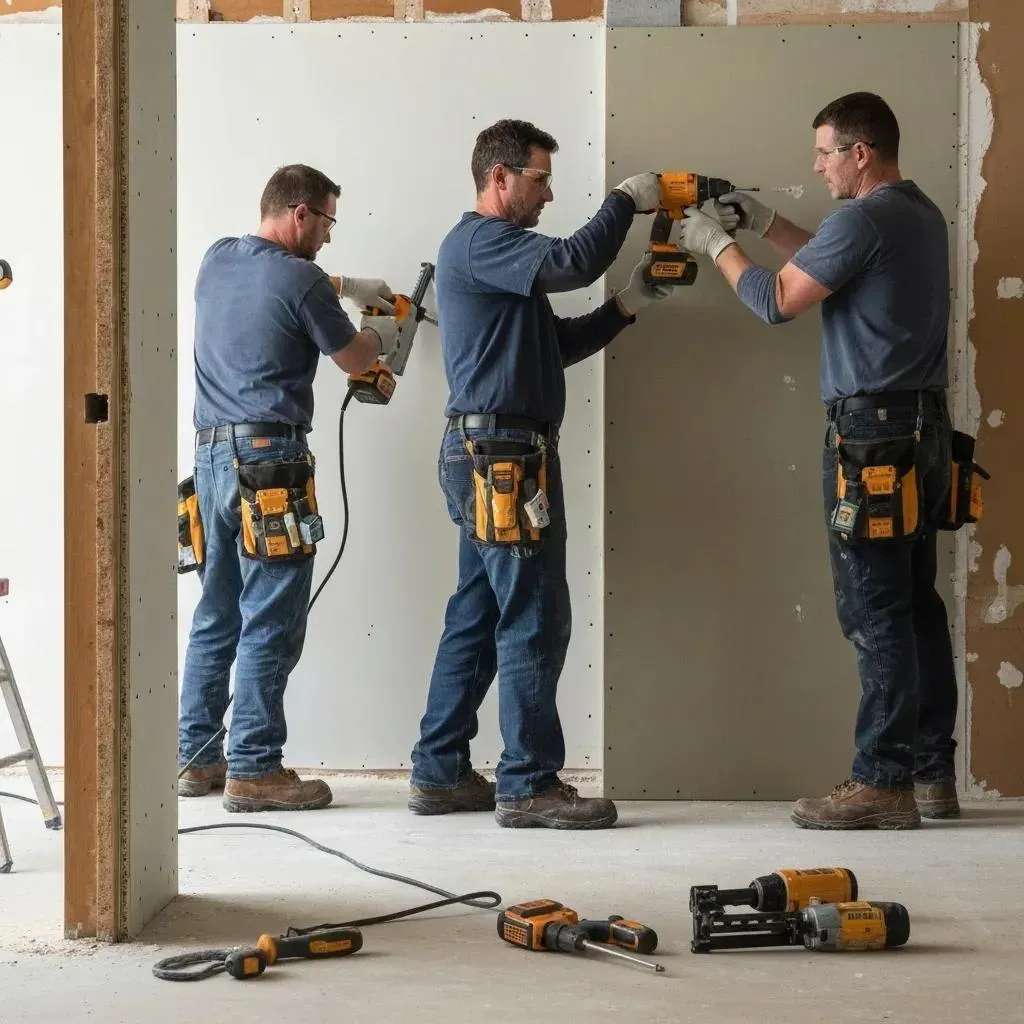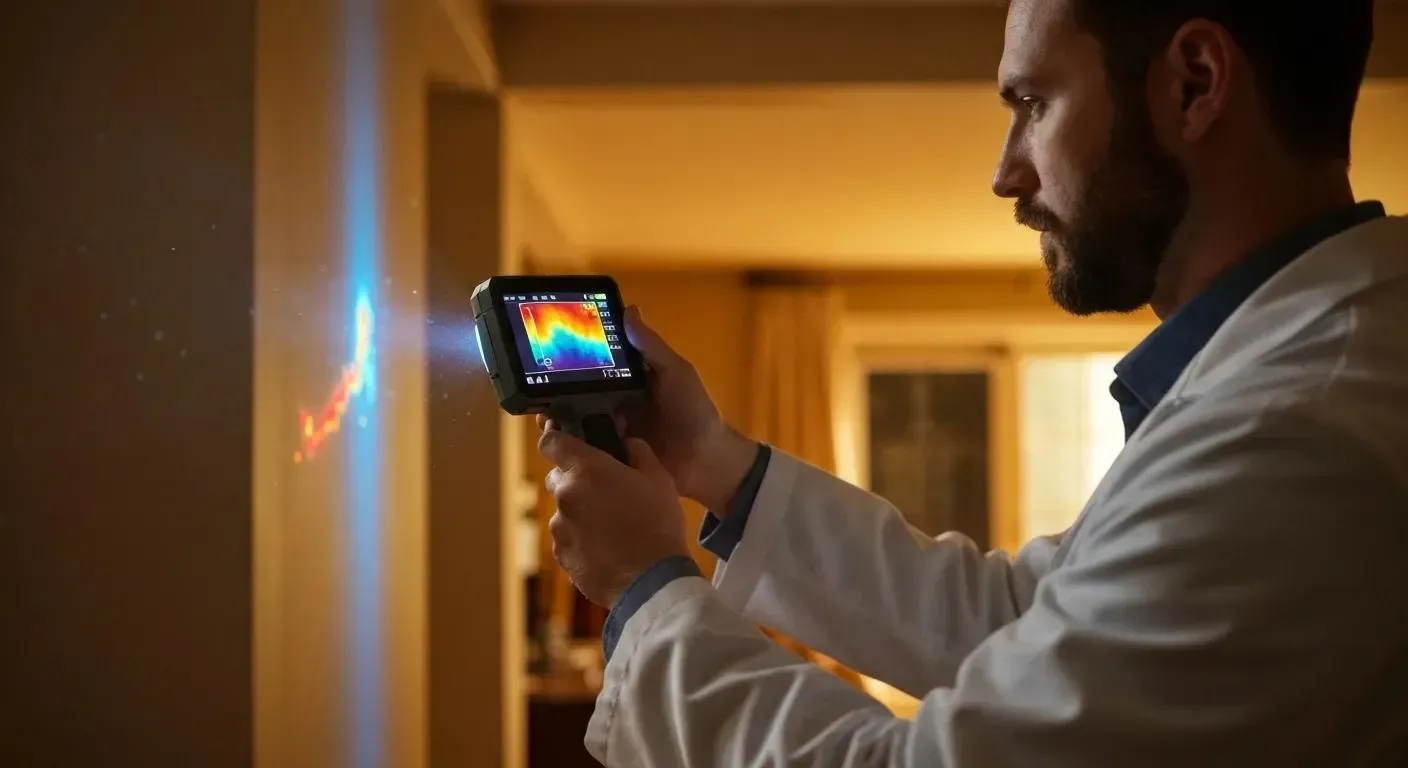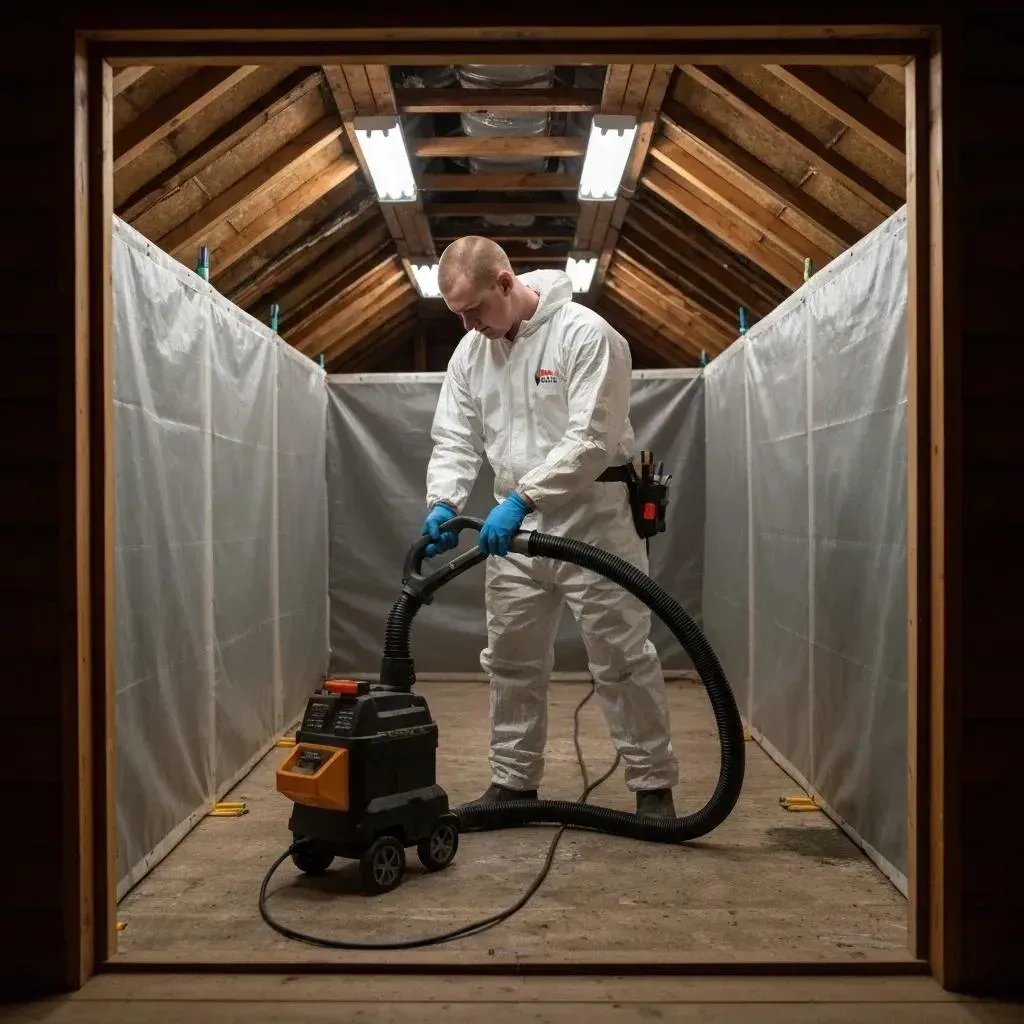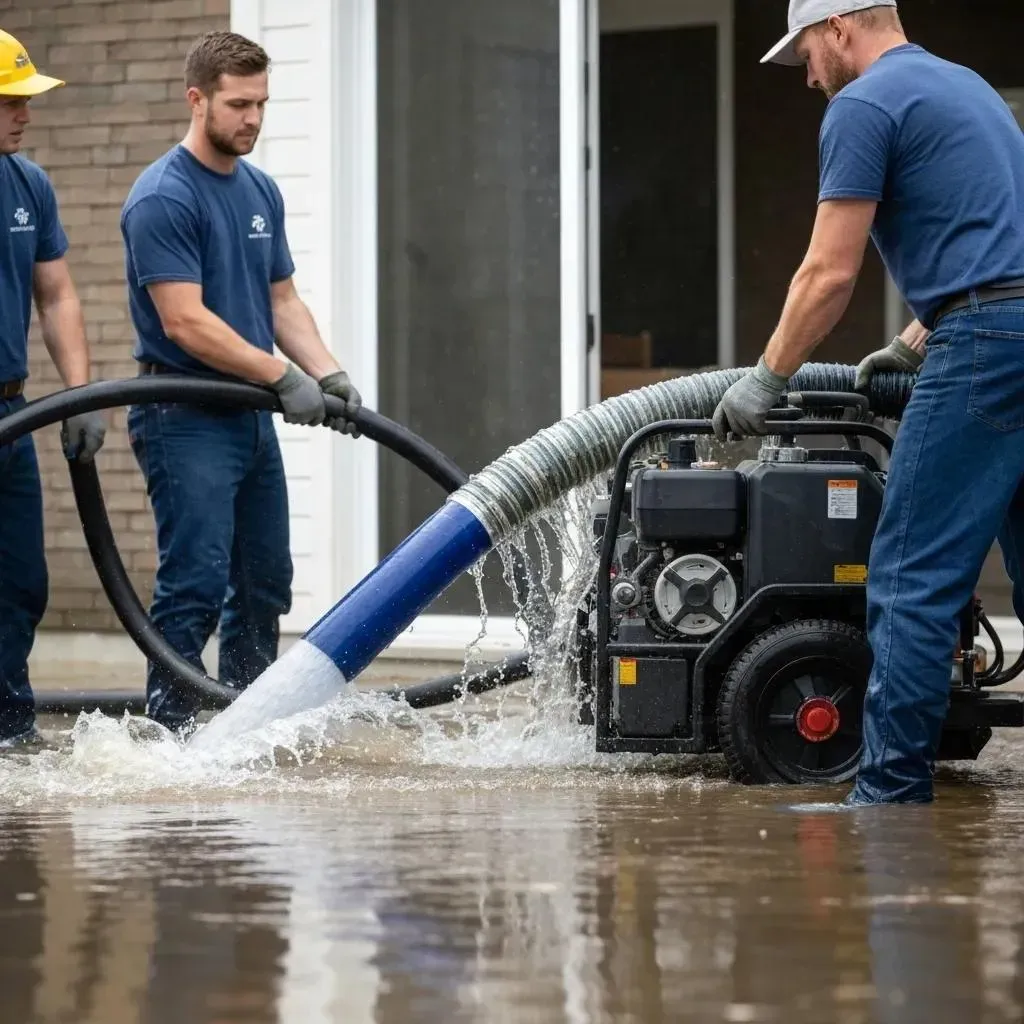Blog
When Disaster Strikes: Water Damage Restoration Tips for Immediate Action
If you're facing water damage in your home, here are the essential water damage restoration tips you need right now:
- Safety first- Turn off electricity and wear protective gear
- Stop the water source immediately
- Document everything with photos for insurance
- Remove standing water with pumps or wet/dry vacuums
- Dry thoroughly with fans and dehumidifiers within 24-48 hours
- Assess and remove damaged porous materials
- Disinfect all affected surfaces
- Monitor humidity levels (keep below 60%)
Water damage restoration tips are critical for any homeowner to know, as water intrusion can quickly escalate from a minor inconvenience to a major disaster. Whether from a burst pipe, overflowing appliance, or severe weather, acting within the first 24-48 hours is crucial to prevent mold growth and structural deterioration.
I'm Mike Martinez, owner of Accountable Home Services, with over 15 years of experience implementing water damage restoration tips for Denver homeowners facing everything from minor leaks to catastrophic flooding. My IICRC certification and hands-on experience have taught me that quick, proper response makes all the difference in minimizing damage and costs.

Know Your Water: Categories & Risks
When water invades your home, understanding exactly what type of water you're dealing with can make all the difference in how you approach cleanup.
Contamination Spectrum Explained
Water damage comes in three distinct categories:
Category 1 (Clean Water) comes from clean sources like broken supply lines or overflowing bathtubs. While it's the least concerning type, it can degrade into something more serious within 24-48 hours if left untreated. At around $3.75-$4.25 per square foot to mitigate, Category 1 damage is your best-case scenario.
Category 2 (Gray Water) contains significant contamination that might make you sick if consumed or touched. Think dishwasher overflow or washing machine discharge. This requires careful handling and proper protective gear. Professional mitigation typically costs $4.10-$6.50 per square foot.
Category 3 (Black Water) is grossly contaminated with pathogens and toxins, coming from sewage backups, river flooding, or long-standing water. This is absolutely not a DIY situation and typically costs $7.00-$7.50 per square foot for professional remediation. When dealing with black water, following proper greywater and black water guidelines is essential for safety.
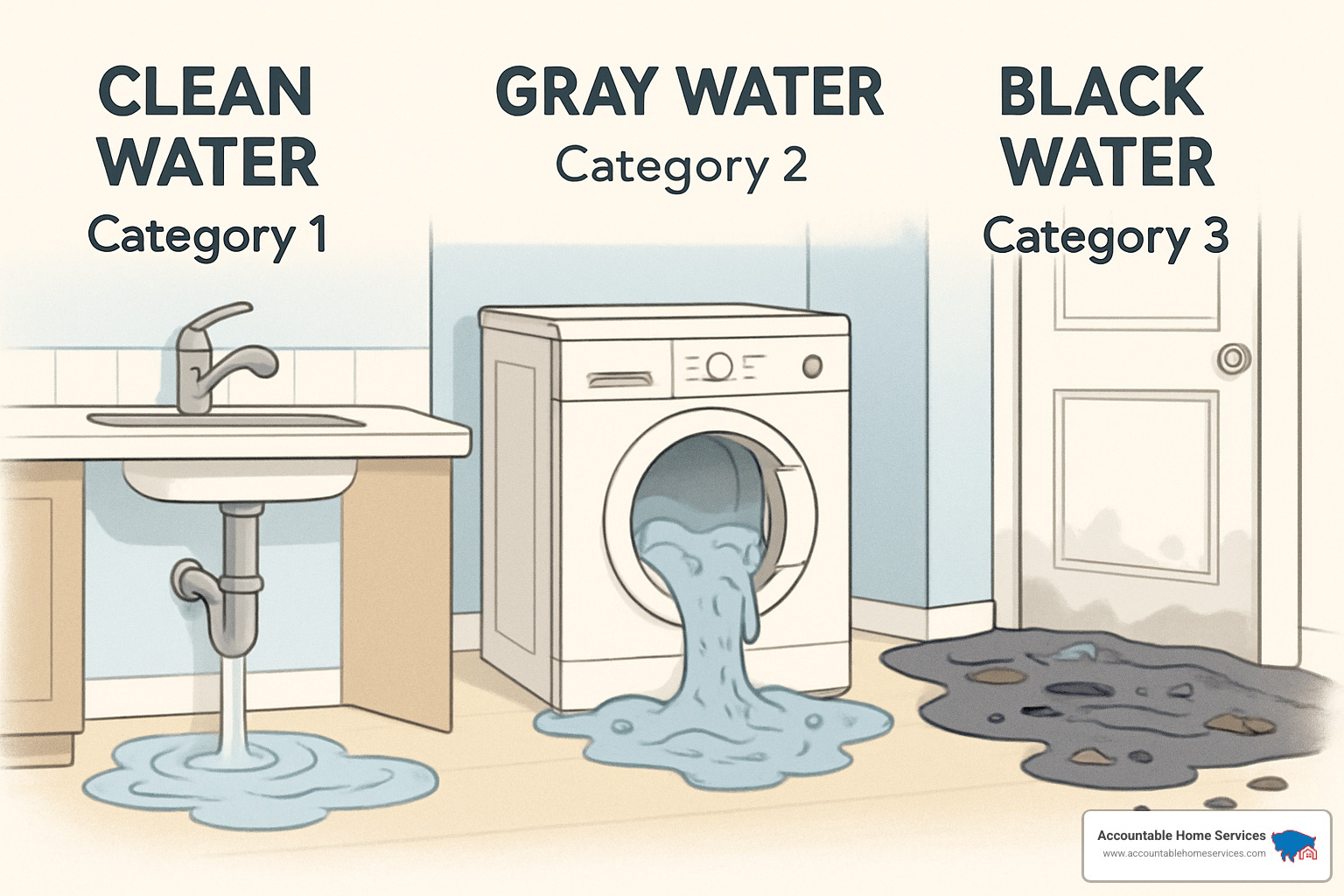
Structural & Health Consequences
Water damage is a race against time:
Within minutes, water spreads rapidly, soaking everything in its path.
Within hours, drywall begins to swell and break down. Furniture finishes start bleeding, and household odors intensify.
Within 24 hours, drywall continues deteriorating, metal surfaces tarnish, and furniture warps.
Within 48 hours, mold starts growing, doors and windows swell, and wood flooring warps. This is the critical threshold where water damage restoration tips become absolutely essential.
Within 1 week, structural wood swells and splits, mold growth accelerates, and biohazard contamination becomes a serious possibility.
Denver's unique climate presents special challenges. The dry air can mask moisture problems, creating a false sense of security while moisture remains trapped in walls. Using professional-grade moisture meters is crucial for detecting hidden water. We recommend maintaining indoor relative humidity between 40-60% to prevent both mold growth and wood rot.
Water Damage Restoration Tips: 10 Immediate Actions
When water invades your home, the clock starts ticking. Here are the critical first steps you'll want to take:
Shut off the water source immediately if you can safely reach the valve. Next, turn off electricity to affected areas at your breaker box—water and electricity create a dangerous combination.
Once safety is established, document everything with photos for insurance. Then quickly remove valuable items from wet areas to prevent further damage to irreplaceable possessions.
Getting rid of standing water becomes your next priority using pumps, wet/dry vacuums, or mops and buckets. Follow this by increasing air circulation —set up fans and open windows if outside humidity is lower than inside.
Dehumidifiers are your best friends in these situations, pulling moisture from the air to prevent mold growth. You'll want to remove saturated materials that can't be saved, like soaked carpet padding or drenched insulation.
Don't forget to lift furniture onto aluminum foil or wooden blocks to prevent staining. And perhaps most importantly, contact professional restoration experts, especially if dealing with Category 2 or 3 water contamination.
#1 Safety First – Water Damage Restoration Tips for a Secure Site
Before rushing in to save belongings, take these precautions:
Always wear protective gear including rubber boots, waterproof gloves, and N95 masks. Check carefully for electrical hazards before entering standing water.
Be alert to structural warning signs like sagging ceilings or warped floors. Watch your step on slippery surfaces, and always be aware of potential gas leaks —if you detect that distinctive rotten egg smell, leave immediately and call your utility provider.
"One of the most dangerous situations is when homeowners attempt to enter flooded basements where electrical panels are located," our safety coordinator reminds clients. "Always call a professional if you're unsure about electrical safety." More info about emergency steps
#2 Stop, Document, Call – Water Damage Restoration Tips for Smart Homeowners
Your insurance claim starts the moment water damage occurs:
Take clear, date-stamped photos of everything before you start moving items. While documenting, create a detailed inventory of damaged belongings with approximate values.
If you need to dispose of severely damaged materials before an adjuster arrives, save small samples as evidence. And be meticulous about keeping receipts for any emergency purchases or cleanup supplies.
When it's time to call for professional help, look for restoration companies with IICRC certification, which ensures technicians follow industry-standard protocols. The best companies offer 24/7 emergency response, direct insurance billing, and transparent pricing. Institute of Inspection, Cleaning, and Restoration Certification
"The most common mistake is homeowners starting cleanup without proper documentation," shares our claims specialist. "Insurance adjusters need visual evidence to approve your claim."
Drying & Mold Prevention Methods
Proper drying isn't just important—it's everything when it comes to water damage restoration. The race against time begins the moment water enters your home.
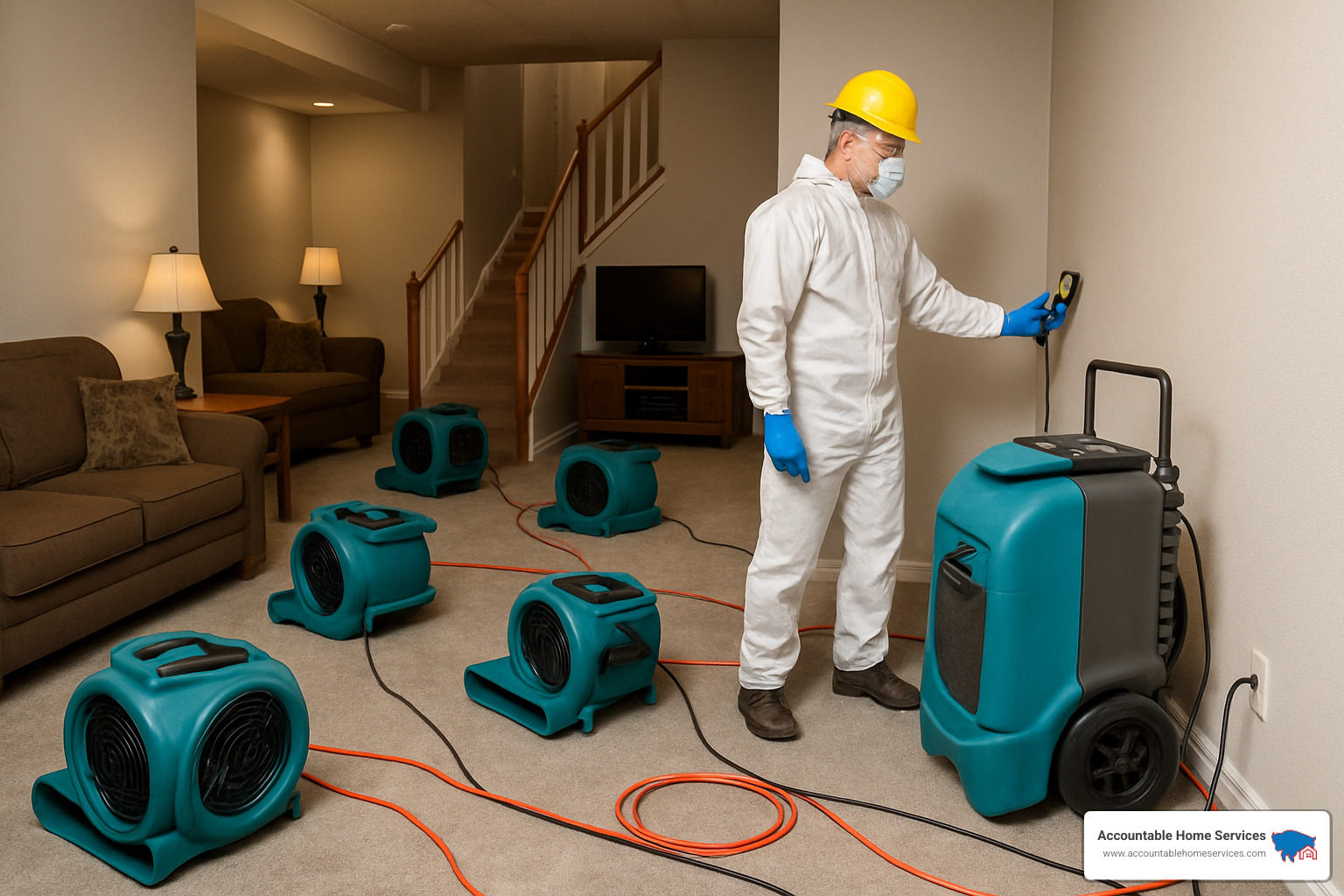
Best Practices for Complete Dry-Out
When we approach a professional dry-out, we're thinking in layers and systems, not just surfaces.
Strategic equipment placement makes all the difference. We position air movers at 45-degree angles to walls, typically using one air mover for every 10-16 linear feet. This creates a vortex effect that lifts moisture from materials and pushes it into the air where dehumidifiers can capture it.
We also practice layer drying —methodically addressing each component of your home's construction. Your hardwood floor might be just the visible layer, but we're equally concerned about the subfloor beneath it and the joists below that.
Taking daily moisture readings tells us where to adjust equipment for maximum efficiency. In Colorado's unique climate, we maintain temperatures between 70-80°F while keeping relative humidity below 60%.
Sometimes walls need help breathing. That's when we might recommend removing baseboards or making small flood cuts in drywall about 12-24 inches above the water line to allow air circulation inside wall cavities.
"The dry air in Denver can be both a blessing and a curse," I often tell clients. "While it helps surface drying, it can create a false sense of security while moisture remains trapped in building materials."
DIY Gear vs. Rental Equipment
If you're facing a small Category 1 water incident, you might consider the DIY route, but understand the limitations of consumer-grade equipment.
Your household fans and dehumidifier can help with surface drying, but they can't match professional equipment. A standard household dehumidifier might remove 10-20 pints of water daily, while commercial units extract 70-140 pints in the same timeframe.
For those determined to handle it themselves, equipment rental is worth considering. You can typically rent commercial air movers for about $25-50 per day and LGR dehumidifiers for $75-125 daily.
For a modest 200 square foot area with Category 1 water damage, the cost comparison looks like this:
- DIY with purchased equipment: $300-500
- DIY with rental equipment: $200-350 for 3 days
- Professional service: $1,000-1,500
The price difference might seem significant, but consider what you're buying with professional service: expertise, proper equipment, and peace of mind. Our technicians follow detailed procedures outlined in our Water Damage Repair Steps to ensure nothing is overlooked.
Handling Damaged Materials, Cleanup Gear & Insurance
When the water recedes, you're left with tough decisions about what to save and what to toss.
Material Salvageability Guide
Water damage doesn't treat all materials equally. Here's what you need to know:
| Material | Category 1 Water | Category 2 Water | Category 3 Water |
|---|---|---|---|
| Drywall | Salvageable if dried within 24-48 hours | Replace if wet for >24 hours | Always replace |
| Insulation | Usually requires replacement | Always replace | Always replace |
| Solid wood | Generally salvageable with proper drying | Salvageable with cleaning and disinfection | Case-by-case basis |
| Engineered wood | Often warps; case-by-case basis | Usually requires replacement | Always replace |
| Carpet | Salvageable with professional cleaning | Sometimes salvageable with professional cleaning | Always replace |
| Carpet padding | Almost always replace | Always replace | Always replace |
| Upholstered furniture | Sometimes salvageable | Rarely salvageable | Never salvageable |
| Hard furniture | Usually salvageable | Often salvageable with disinfection | Sometimes salvageable with restoration |
| Electronics | Varies; professional assessment needed | Varies; professional assessment needed | Rarely salvageable |
"The most heartbreaking situations are when homeowners try to save items that should be discarded, especially after sewage backups," I've often told clients. "Some things simply can't be safely cleaned, no matter how much they mean to you."
Choosing Professional Help
Not all restoration companies are created equal. Look for these crucial qualifications:
IICRC WRT certification is the gold standard—it means technicians understand the science of drying, not just how to place equipment.
Proper licensing and insurance protects both you and the workers in your home.
Advanced equipment makes all the difference between a complete restoration and lingering problems.
Transparent pricing should be non-negotiable. We provide detailed scopes of work before starting, so there are no surprise bills.
Local expertise matters tremendously in Denver, where our unique climate affects drying times and methods.
Response time can make or break your restoration. "At Accountable Home Services, we guarantee a response within 90 minutes for emergency water damage in the Denver Metro Area," our dispatch team notes.
For more insights, check out What to Expect When You Call a Water Damage Restoration Expert.
Budget & Rebuild Considerations
Water damage restoration costs vary based on several factors:
Extent of damage – A small leak contained to one room will cost significantly less than whole-house flooding.
Water category – Clean water is less expensive to mitigate than contaminated water.
Affected materials – Hardwood floors typically cost more to restore than carpet.
In the Denver area, you can generally expect:
- Water extraction: $3.75-$7.50 per square foot depending on water category
- Drying and dehumidification: $1,000-$2,700 total
- Mold remediation (if needed): $15-$30 per square foot
Many homeowners wonder if insurance will cover these costs. For clarity on this important question, visit Does Homeowners Insurance Cover Water Damage? Find Out.

Frequently Asked Questions about Water Damage Restoration
How long before mold starts to grow?
In most homes, mold begins its unwelcome appearance within just 24-48 hours after water exposure. Here in Colorado, our drier climate might slow visible mold development, but it's often secretly thriving in wall cavities and other hidden spaces where moisture gets trapped.
"Many Denver homeowners are surprised when we detect mold they can't see," explains our remediation specialist. "We use thermal imaging cameras to spot temperature differences that signal hidden moisture."
This rapid mold timeline is precisely why our water damage restoration tips emphasize immediate action. Every hour counts when it comes to preventing those microscopic spores from settling in.
Can I clean up gray water myself?
While technically possible to handle Category 2 (gray) water cleanup yourself, I strongly recommend calling in professionals. Gray water contains significant contamination that requires proper protective equipment and thorough sanitization.
If you're determined to tackle it yourself, follow these essential water damage restoration tips:
- Wear comprehensive PPE (heavy-duty gloves, rubber boots, N95 mask, eye protection)
- Remove and properly dispose of saturated porous materials like carpet padding
- Clean all surfaces with a professional-grade disinfectant approved for biohazard cleanup
- Thoroughly dry the area with commercial-grade equipment
- Monitor the area vigilantly for mold growth for several weeks afterward
"I've seen too many DIY gray water cleanups lead to serious health issues," our biohazard specialist warns clients.
Will my insurance premium increase after a claim?
The honest answer depends on several key factors:
Claim history plays a major role—filing multiple claims within a short timeframe is more likely to trigger premium increases than a single incident.
The cause of damage matters significantly. Sudden, accidental damage (like a burst pipe during winter) is viewed more favorably than gradual damage from poor maintenance.
Claim amount can impact your future premiums—larger payouts may have more significant effects on your rates.
Insurance company policies vary widely—each carrier has their own approach to handling claims.

"At Accountable Home Services, we understand this concern," says our insurance coordinator. "That's why we work directly with insurance companies to handle claims efficiently. We provide detailed documentation and collaborate closely with adjusters to ensure fair coverage while minimizing potential impacts on our clients' premiums."
Prevention: The Best Water Damage Restoration Tip
Let's be honest—dealing with water damage is stressful, expensive, and disruptive. While knowing how to respond when disaster strikes is essential, the smartest water damage restoration tip is preventing the problem in the first place.
As we often tell our Denver clients, an ounce of prevention truly is worth a pound of cure. I've seen how a simple $10 washing machine hose replacement could have prevented a $10,000 water damage claim.
Here's what every Colorado homeowner should be doing:
Inspect your plumbing regularly. Take a few minutes each month to look under sinks, around toilets, and behind appliances for small drips or warning signs.
Give your water heater some TLC. These workhorses need annual flushing to remove sediment, and most should be replaced after 10-12 years.
Adopt smart home technology. Water detection devices can alert homeowners to leaks before they become catastrophes. Some can even automatically shut off your water main.
Know your shut-off valves. Everyone in your household should know where the main water shut-off is located and how to use it.
Colorado's unique climate presents special challenges. Our freezing winter temperatures can cause pipe bursts if not properly insulated. A little winterization goes a long way in our climate.
Maintain your home's exterior defenses too. Clean gutters and properly positioned downspouts direct water away from your foundation, preventing seepage into basements and crawlspaces.
High water pressure might feel nice in the shower, but it puts tremendous strain on your plumbing system. Consider installing an inexpensive pressure regulator if your home's water pressure exceeds 80 psi.
"The most frustrating calls we get are for disasters that could have been easily prevented," shares our preventive maintenance specialist. "That small water stain on the ceiling that was ignored for months? It eventually became a collapsed ceiling and major restoration project."
The best water damage restoration tip isn't about how to clean up after a disaster—it's about making sure that disaster never happens in the first place.
Conclusion
When water invades your home, those first few moments can feel overwhelming. But with the right knowledge and quick action, you can turn a potential disaster into just a bump in the road.
Throughout this guide, we've shared essential water damage restoration tips that can make all the difference between a simple cleanup and a costly reconstruction project. Time is truly of the essence—every hour that passes allows water to seep deeper into your home's structure.
For minor Category 1 incidents, a DIY approach might work if you have proper equipment and know-how. But when dealing with contaminated water, larger affected areas, or when structural elements are compromised, professional help isn't just convenient—it's essential for your family's safety and your home's integrity.
Here at Accountable Home Services, we've guided Denver families through water emergencies of every size and severity. Our IICRC-certified technicians respond 24/7, ready to minimize damage, prevent mold growth, and restore your home quickly and safely.
We're also passionate about prevention. Consider scheduling a home inspection to identify potential water risks before they become problems. Those small investments in maintenance—replacing aging washing machine hoses, checking water heater connections, or upgrading to a smart leak detection system—can save you thousands in potential damage.
If you're currently facing water damage in Denver, Westminster, Thornton, or anywhere in the Metro area, don't wait. Call our team at Accountable Home Services for immediate assistance. We offer direct insurance billing and guarantee a rapid response to get your life back to normal as quickly as possible.
For more information about our water damage restoration process or to schedule preventive maintenance to avoid future water damage, visit our website or call our 24/7 emergency line. We're your neighbors, here to help when you need us most.


